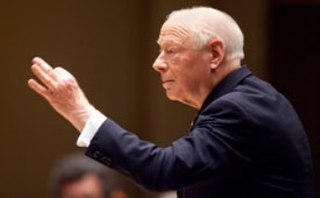|
Back
Nature, Haitink-Mahler Style New York
Avery Fisher Hall, Lincoln Center
05/15/2014 - & May 16, 17*, 2014
Gustav Mahler: Symphony No. 3 in D Minor
Bernarda Fink (Mezzo-Soprano)
Women of the New York Choral Artists, Joseph Flummerfelt (Conductor), Brooklyn Youth Chorus, Dianne Berkun-Menaker (Artistic Director), New York Philharmonic Orchestra, Bernard Haitink (Conductor)

B. Haitink (© Matthias Creutziger)
I have only a single problem with Bernard Haitink’s majestic performance of Gustav Mahler’s Third Symphony last night with the New York Philharmonic. Mahler stressed time and again that the first movement “ceased to me music”, and that it was the sounds of nature which he was trying to portray.
Mr. Haitink gave a masterful show of this first movement, the themes were big and broad, the sledgehammer trombones and horns were given mighty sounds. But did it come near to Mahler’s “nature”? One has doubts.
Granted, Mahler’s “nature” was not the insectivorous nature of Bartók’s insects or Messiaen’s birds. It was the nature of Shiva, creating and destroying at the same time. Mr. Haitink gave us a performance which never ever lacked authority, greatness, the most ravishing mezzo-soprano solo. Yet I somehow felt that was the work of a great symphonist and a mightily great conductor, not the Mahler who insisted that “the symphony must contain the whole world.”
That though was a personal quibble, for this was still a mighty performance, all 98 minutes of it, with an audience mesmerized, without a sound even between the movements. (On a personal note, I’d been suffering from a quasi-flu, and wasn’t certain I could get through it without a stifled cough or two. From the moment of those first desolate horns to the full orchestral benediction at the climax, not a single tickle ever erupted. Music really does have charms to soothe this ravished breast!)
The New York Philharmonic played at their best, albeit with a fluff or two from the overworked horns. But above all were the solos by Glenn Dicterow, a violinist who really did encompass that feeling of nature, of sweetness without cloying.
After the wispy minuet came the other solo, which some of us look for. Matthew Muckey’s posthorn solos were clear, soothing, on target, with just that fractional pause before the final high note.

B. Fink (© Courtesy of the artist)
The solo by Bernarda Fink was, indeed a thing of ravishing beauty. Ms. Fink, sitting motionless on the stage, her face an ethereal mask (I was reminded of Greta Garbo in the last scene of Queen Christina), rose literally to the occasion, her first notes “Oh, mankind” as forceful at Mr. Haitink’s opening notes of the symphony. The rest, from that so lovely poem (Mahler was unapproachable in his choice of poetry) balanced the forceful start with a more lyrical tone, lyrical yet held back, sublime rather than searing.
The treble voices–the women of the New York Choral Artists, and the Brooklyn Youth Chorus, rang their tintabulations and sung their verses not with enthusiasm but the lightness nimble abilities so well needed here.
We come to the final movement, that Mahleresque blessing, benediction, praise, subdued hosanna...Whatever you want to call it. Bernard Haitink has conducted Mahler thousands of times in his career, he is arguably the world’s pre-eminent Mahler conductor, and he never let go of this so powerful ending for a second. This was affection and appreciation, full orchestral swells and subsidings, ensemble prayers and solo instrumental suppliance. The tension he produced was not frightening but consecrating. Whatever “nature” Mahler was aiming for, Haitink produced in these last 15 minutes, as Mahler’s thanks to the universe which, at that point in his all too short life, encompassed glow, radiance and gratefulness.
Harry Rolnick
|